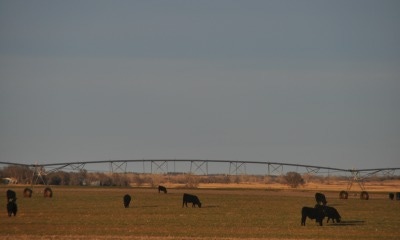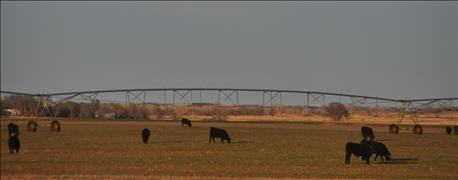
If you think its's awfully warm for February, you're right.
Forecasters are predicting it will remain that way for at least another week -- the forecast for the next 10 days is highs in the 60s and 70s. That has more than a few folks getting worried about the hard red winter wheat crop breaking dormancy and starting to grow, which would make it vulnerable to a late freeze if a cold snap hits in late March, as it so often does.
It also means that folks who double-purpose their wheat crop for winter forage need to be keeping a close eye on those fields and be ready to pull cattle off if wheat begins to grow, according to Romulo Lollato, Kansas State University wheat specialist.

WHEAT PATURE: Cattle graze on wheat pasture beneath a center pivot. With unseasonably warm weather forecast for lthe next week to 10 days, wheat growers have concerns about an early break from dormancy.
Lollato was one of the speakers at a Kansas Grasslands and Forage Council Conference in Garden City on Feb. 11. He cautioned that grazing past "first hollow stem" growth stage can seriously decrease grain yields at harvest.
To determine how close to that stage your field is, you need to pull up a plant from an ungrazed portion of the field, he said, advising that a plant just outside the electric fence at the edge of the field would be ideal.
Split the largest tillers open lengthwise. You have reached first hollow stem if there is about half an inch of hollow stem below the nodule that will develop into the head.
In optimum growing conditions, which much of Kansas has had this season, the yield loss is about 1% per day of grazing past first hollow stem. If fields area already stressed by drought or harsh conditions, the loss can be 5% a day for each day of grazing past that stage.
Lollato said winter wheat grazing is common in the southern Great Plains is Kansas, Oklahoma and Texas where 20 million acres of winter wheat are planted annually. About 8 million acres of that total are grazed yearly.
In a typical grazing season, ranchers get about 120 to 150 days of wheat pasture each year, depending on how soon after planting the root system is strong enough to withstand grazing and how early in the spring the break from dormancy occurs.
Lollato said that producers should be keeping a close eye on fields if the warm weather persists. One factor that may slow down growth is that nighttime lows are still forecast to drop to near freezing.
About the Author(s)
You May Also Like




